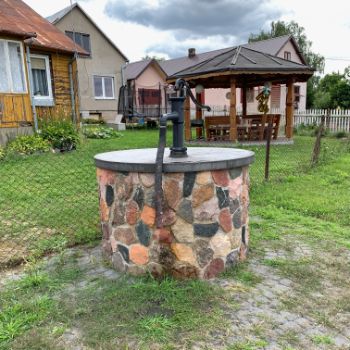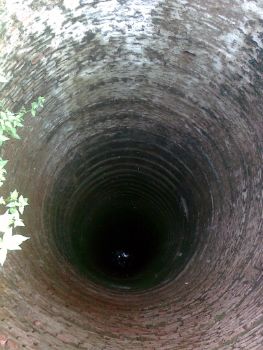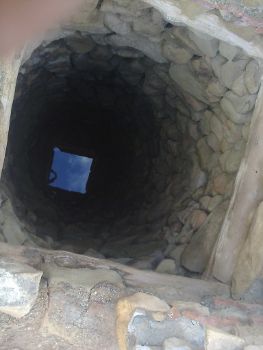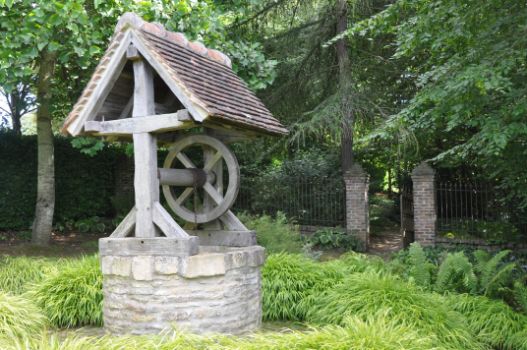A water well usually lasts 30-50 years, but some wells can dry sooner or within a decade. The reasons well water can run out sooner than expected can be natural, manmade or maintenance related. This article explains the common reasons well water runs out, signs of a well going dry, and how to fix a dry well.

Probable Reasons Well Water Can Run Out
Natural/Environmental Reasons
Depleting Groundwater Levels
Water wells obtain water from underground aquifers. The underground water level reduces with scanty rainfall or draught accompanied by constant pumping. Prolonged drought has a long-lasting effect on underground water levels and usually takes years to recover. The recovery is often aided by hydro-fracturing.
Depleted groundwater can also reduce water levels in surface water sources, affect water quality, and cause soil sinking. You may have to replace the water pump with a larger one, which can lead to higher pumping costs.
There are many examples of groundwater depletion in the US. It has been reported in the Atlantic coastal plain, Gulf coastal plain, Pacific Northwest, and Chicago-Milwaukee region.
Drought/Reduced Precipitation
The main reason behind depleting groundwater is the lack of rainfall or drought. When there is low rainfall but no drop in water usage, the aquifer doesn’t get enough water to replenish.
The water levels start to reduce gradually, and the well dries eventually. It is pertinent to highlight that you are not the only one drawing water from one aquifer. Your neighbors’ wells may also be drawing water from the same aquifer.
Precipitation is a blanket term for rain, drizzle, snow, hail, sleet, and small ice pellets. Fog and mist on plants and grass don’t affect the underground water level too much, but they help keep the ground wet and reduce evaporation.

Reduced Groundwater Recharge
Apart from precipitation, groundwater recharge depends on various other factors. Groundwater recharge is the amount of water entering the earth’s surface into the groundwater. The factors that affect groundwater recharge rate include the following.
Temperature: Higher temperature in a particular area means more evaporation and less water entering the ground.
Evaporation: The evaporation rate impacts how much water seeps from the surface and reaches the aquifer. The soil’s permeability, temperature, and rainfall are crucial in deciding the evaporation rate.
Wind Speed: Areas with high wind speeds have drastically higher evaporation rates than less windy areas. The quicker the air blows in your area, the more evaporation happens, and less water seeps into the ground.
Vegetation/plants/trees: The amount of greenery in an area directly affects the groundwater recharge rate. More greenery (trees, plants, and grass) means better soil, less sunlight, reduced temperature on earth, and more seeping. Greenery is also great for the environment. So, it is a win-win for everyone.
Soil Permeability: Sandy soil allows water seepage quicker than rocky or clay soil. Rocky soils hold the water near the surface, giving more evaporation time.
Please note that these factors gradually contribute to increasing/decreasing groundwater levels. Hence, you may notice their impact before 1-2 decades.
Changing Water Table
The underground water table changes as your well draws water from the well. Water wells built in areas with deep water table don’t face drying issues due to changing water table. These wells aren’t affected by surface-level evaporation like shallow water wells.
Deep-water wells take longer to refill but don’t run out of water before 20-30 years. Shallow water table wells are affected by evaporation and face drying issues more commonly than deep wells.
Man-Made Issues
Usage
Excessive usage can increase the chances of a well going dry. However, it depends on factors like well depth, type of soil, type of aquifer, and how many wells draw water from one aquifer.
Water usage can be controlled by minimizing excessive water chores, such as filling swimming pools, running sprinklers, or other tasks requiring consistent water drawl.
Knowing how much time your well takes to replenish is critical as it can help you control water usage and let the well fill naturally to avoid maintenance and repair issues.

Multiple Wells in an Area
The number of wells tapping a particular aquifer or aquifers directly impacts how long your well supplies water. Suppose there are two wells in one aquifer, but then your neighbors dig a new well in the same aquifer.
It will not only affect the overall life of the well but also reduce the flow and replenishment rates.
The number of wells also affects the cone of depression and drawdown near the well. The cone of depression is the immediate depression near the well when water increases. The drawdown is the difference between the original water table and the cone of depression depth.
These two factors don’t matter if you have 1-2 wells using one aquifer. However, when you have multiple wells nearby, these things can increase the chances of your well going dry.
Hydrofracking (Hydro-fracturing)
Hydrofracking is used to deepen water wells to increase the well replenishment rate. The technique opens the aquifer, allowing more water to enter your well.
However, it can be problematic if neighbors opt for hydrofracking and both wells tap the same aquifer. The only solution in such a situation is to go for hydrofracking for your well.
Well Maintenance Issues
Well Screen
The well screen is located at the bottom, allowing water to enter the well. Over time, the sediment in the water can block the screen. A blocked well screen may not entirely cease water coming from the well, but it can reduce the amount of water entering the well.
The best solution to such problems is to clean your well screen. It is a simple process, but check the local laws before cleaning the well screen, as most states require a licensed contractor to perform such maintenance tasks.

Failing Well Pump
A failing well pump may make you think your well has gone dry. There are various symptoms behind a failing pump, like pump running loud, priming problems, and pump running but no pressure problem.
If you fear that your well is going dry, it is better to check the pump before going for expensive alternatives.
Plumbing Leaks
Water leakages under the line are hard to locate and continuously dissipate underground water. It is important to inspect your plumbing for leaks at least every couple of years.
Note: Well maintenance issues don’t always show that your well has gone dry. Sometimes, these problems can happen randomly without an underlying cause. Hence, it is best to consult a professional before deciding what to do.
Symptoms of a Well going Dry
- Reduced replenishment rate
- Frequent well pump cycling
- Muddy and murky water
- Reduced water pressure and water outage issues
- Weird odor/taste coming from the smell
How to Fix a Dry Well?
There are a few solutions that may bring back a dry well. However, these fixes may not always work. Let’s check out how to bring a well back.
Well Screen Cleaning
Clean the well screen to remove sediment build-up around the well. It will also enhance water quality and increase water pressure.
Deepening the Well
Deepening the well works best for shallow wells. If your well is 50 feet deep, you can make it 80-100 feet deep to tap more water or a larger aquifer. Increasing well depth can also improve water quality.
Lowering Well Pump
Sometimes lowering the well pump can also fix the well running out of water problem. When the water level in the well goes beyond the pump’s intake, it fails to supply water. A well professional can help you decide if lowering the pump will work. Please note that lowering the well pump will only work if you have a submersible pump.
Hydrofracking
Hydrofracking is the most successful (up to 90%) method to bring back a dry well. The method sends a high-pressure water stream down the well to fracture the aquifer, remove sediment or silt buildup, and clear the water passage. Hydrofracking is cheaper than digging a new well and gives great results.
Digging a New Well
The last solution is to dig a new well. A normal well lasts for 20-30 years. So, if your well is over 25-30 years and starts going dry, a new well is a better and more rational decision. It is the most costly solution, but you will not face any issues for 20-30 years. Ensure you properly plug the old well and follow all the local rules while plugging and building a new well.
Preventive Measures to Increase Well Age
- Fix well, faucet, and plumbing leaks to avoid constant withdrawal from well
- Use water responsibly; buy water for filling swimming pools and washing cars if possible.
Frequently Asked Questions
How long does a well last?
A properly constructed well lasts for 20-30 years. Some wells last over 50 years if properly maintained and utilize a huge aquifer.
Can an artesian well go dry?
Yes. An artesian well can gradually dry if the groundwater goes dry. The water that flows out of the artesian well is due to pressure differences in the groundwater. When the pressure difference reduces or the groundwater level gets low, the artesian well can dry.
How fast does a well replenish?
It depends on well depth, well screen condition, aquifer health, and environmental factors like humidity, evaporation rate, rainfall, and average temperature. The average rate for a well to replenish is 5 gallons per minute. A 600-gallon well will take 2 -3 hours to replenish, and a 900-gallon well will take 3-4 hours.
